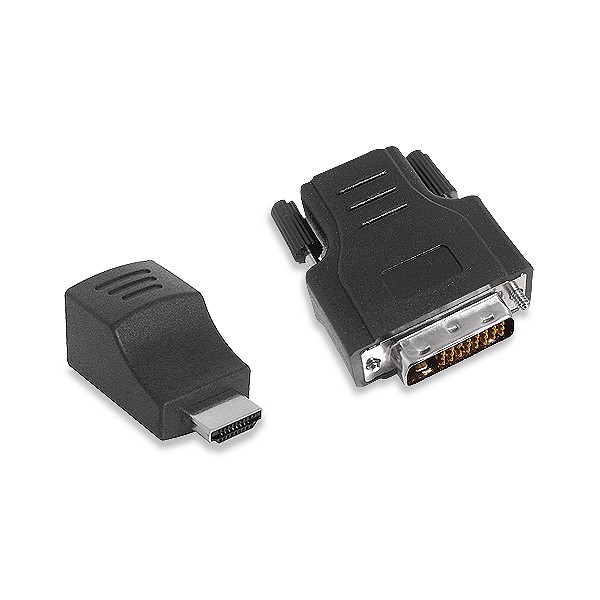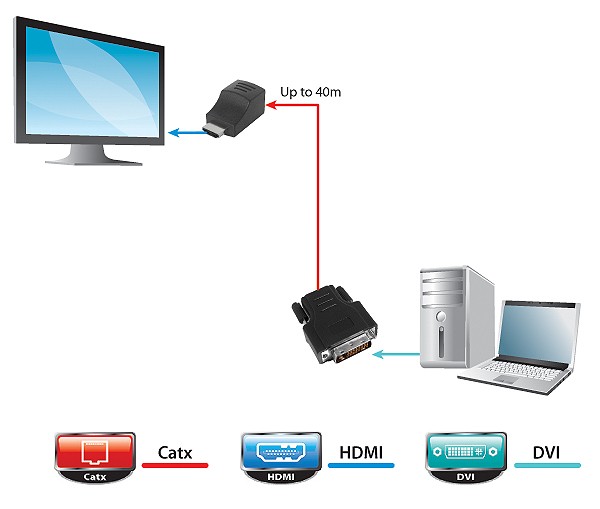- AcePro-CE20-1
- AcePro DVI to HDMI Mini-Extender over single cat5e cable, Full-HD 1080p 60Hz, 25m
■ An affordable solution to convert DVI video to HDMI format and transmits the signal via a CAT5e/6 cable to greater distance than its ordinary cable supported range ■ Enhances the DVI source player to be more compatible to the latest HDMI display unit ■ Ultra-compact transmitter adapter can be directly plugged into the DVI output port of source unit without additional DVI link cable ■ Ultra-compact receiver adapter can be directly plugged into the HDMI input port of display unit without additional HDMI link cable ■ Both TX/RX units are designed with low energy demand, no external power adapters required ■ Sends video of 720p/1080i (RES) up to 130ft and 1080p (RES) up to 80ft
Highlights
An affordable solution to convert DVI video to HDMI format
and transmits the signal via a CAT5e/6 cable to greater distance than its ordinary cable supported range
Enhances the DVI source player
to be more compatible to the latest HDMI display unit
Ultra-compact transmitter adapter
can be directly plugged into the DVI output port of source unit without additional DVI link cable
Ultra-compact receiver adapter
can be directly plugged into the HDMI input port of display unit without additional HDMI link cable
Both TX/RX units are designed with low energy demand
no external power adapters required
Sends video of 720p/1080i (RES) up to 130ft and 1080p (RES) up to 80ft
Package Contents
DVI Mini-Transmitter (TX)
HDMI Mini-Receiver (RX)
Installation guide
Specification
DVI 1.1 compliant, single-link DVI
Video bandwidth: 1.65 Gbps
Resolution and Distance:
■ 720p / 1080i: 130ft / 40m
■ 1080p: 80ft / 25m
Transmitter:
■ 1x DVI-D (digital only), Male
■ 1x RJ-45
■ Weight: 0.10 lbs
Receiver:
■ 1x RJ-45
■ 1x HDMI, 19-pin, Male
Weight: 0.06 lbs
Power consumption: 5 Watts (max)
Certifications/Standards: RoHS
Warranty: 1 years limited
Country of origin: China
Download
FAQ
- Q: What is “HDCP”?
- HDCP stands for High-Bandwidth Digital Content Protection, a copy protection scheme to eliminate the possibility of intercepting digital data midstream between the source to the display. The format designed by Intel and licensed by Digital Content Protection, LLC using an authentication and key exchange procedure before video and audio is presented. Products compatible with the HDCP scheme such as DVD players, satellite and cable HDTV set-top-boxes, as well as few entertainment PCs requires a secure connection to a compliant display, the process often described as the handshake. Due to the increase in manufacturers employing HDCP in their equipment, it is highly recommended that any HDTV you purchase is compatible. Although most video devices support high-definition video over component output, analog connections are scheduled to phase out in the future or possibly forced to limited resolutions output.
- Q: What different between HDMI 2.0 & HDMI 1.4 when use 4K resolution?
- HDMI 1.4 introduced the kind of bandwidth required to deliver 4K video, but HDMI 2.0 can dole out 4K video without compromise, at 50 and 60 frames per second. In HDMI 1.4, the rate of 4K was limited to 24 frames per second. 4K logo 24p and 30p are perfect for watching films, but there are times when the extra speed of 50p and 60p come in handy. Gaming could make great use of 60p content, while more films are being shot at higher frame rates, giving quite a different look from that of slow old traditional cinema.
- Q: What is “EDID”?
- Extended Display Identification Data is a VESA standard data format that contains basic information about a monitor and its capabilities, including vendor information, maximum image size, color characteristics, factory pre-set timings, frequency range limits, and character strings for the monitor name and serial number. The information is stored in the display and is used to communicate with the system through a Display Data Channel (DDC), which sites between the monitor and the PC graphics adapter. The system uses this information for configuration purposes, so the monitor and system can work together.





